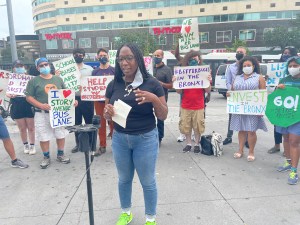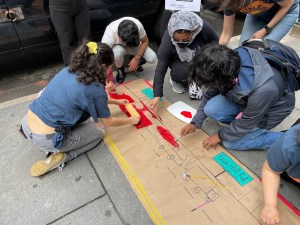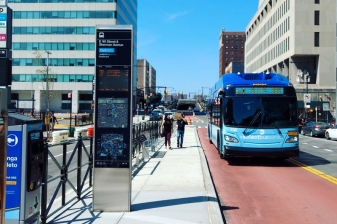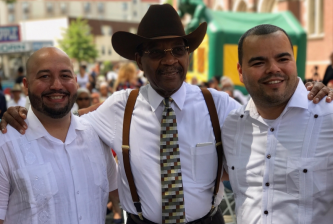EYES ON THE STREET: A Bronx Bus Lane that Underwhelms
The University Avenue bus lane could've been a contender. But it's short, and you can barely see it under the parked cars. Paging Mayor Adams!
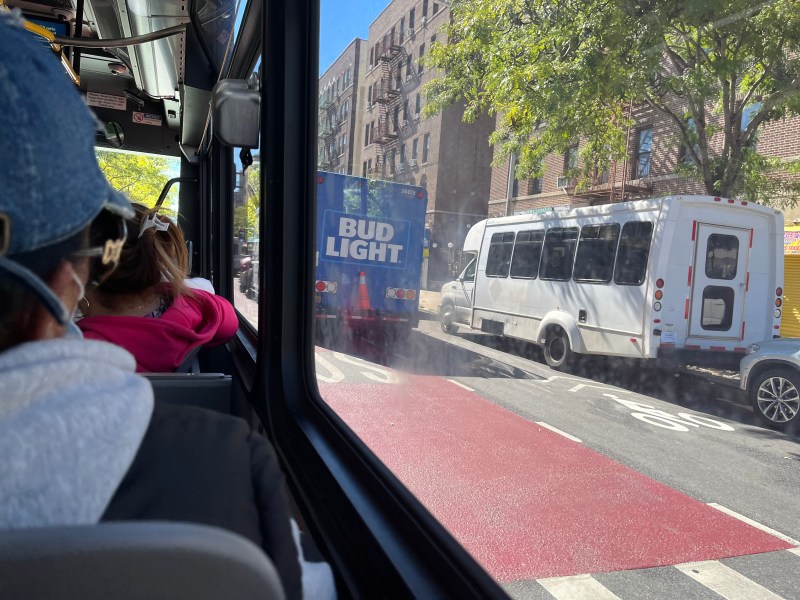
Bronx bus riders can’t seem to catch a break.
Even when the city throws them a bone in the form of a new dedicated bus lane, drivers immediately ruin it.

Recently Streetsblog rode the entire route of the Bx3 — which begins its run at 179th and Broadway in Washington Heights and terminates under the elevated at 238th and Broadway in Kingsbridge — in order to experience the new University Avenue bus-priority lane. The Bx3 has 24 stops; 10 are on University.
The Bus Turnaround Coalition gives the Bx3 a grade of “F.” It has about 11,000 daily riders and lost more than 10 percent of its ridership from 2018 to 2019 because of its ridiculously slow average speed of 6.4 mph (compared to an average of 8.2 mph citywide).
The speeds have risen a bit since the lane has been put in: Peak-hour speeds were 7.2 mph in July, having jumped from 6.7 mph in April when the bus lane was put in. Off-peak speed was 7.8 mph in July. (The citywide average was 8.3 mph that month.)
The Bx3, like most city buses, is crowded and transports many elderly and disabled riders; among the crowd of about a dozen waiting to board at 238th Street were a wheel-chair bound passenger and two with walkers. By the time it hit the intersection of University Avenue and Fordham Road (still north of the bus-priority lane) it was packed — and it was mid-afternoon, before rush hour — so the full-house bus, the most efficient mode of transportation on the road, could have used a speedy lane.

But the new bus-priority lane begins much below that, south even of the “university” that gives University Avenue its name: Bronx Community College, housed in the former undergraduate campus of New York University, which sold it in 1973.
By the time the bus arrived at its new crimson-colored magic carpet — which runs south of Tremont Avenue to the Washington Bridge — you could barely see the poor new bus lane because motorists had turned it and the adjacent bike lane into a parking lot, practically defeating the purpose. Among the vehicles parked in the bus lane was a Bud Light truck (does anyone in The Bronx even drink Bud Light?), a menacing-looking sedan, and an Access-a-Ride van. This is The Bronx so there is zero enforcement, natch.

Given the obstacles, it took us more than 45 minutes to go the entire route in mid-day traffic, so we’re not sure that the project has improved speeds as much as the promised 25 percent on completion.
We also saw vehicles parked in the bike lane, which has gained the notice of Bike Twitter for constant blockages.
@NYC_DOT Could you please fix the situation on University Avenue btw the Cross Bronx and Tremont Avenue. There are cars constantly parked in the bike lane. Edward L. Grant Highway also has this problem. It’s no use to have a protected bike lane if no one can ride in it. pic.twitter.com/fkl2SQtwrs
— James (@JamesFMcDermott) July 19, 2022
Bus lanes are so hard fought — and when accomplished so ballyhooed — that (silly us!) we anticipated a smooth-riding slice of heaven. Instead, we came away thinking: Is there any other U.S. transit passenger who has been so betrayed as The Bronx bus rider:
- by the city, which can’t seem to alleviate the excruciatingly pace of the slowest buses in America?
- by motorists, who constantly invade the buses’ dedicated space?
The changes along University Avenue were long in the making. The Department of Transportation first took its plan for street improvements, including bus lanes, bike lanes and traffic calming, to Bronx Community Board 7 in April 2020. In July 2021, the DOT outlined plans for a long stretch of bus lanes along the avenue north to Kingsbridge Road, which the DOT told Streetsblog would add about 2.6 miles to the agency’s bus-lane count. The DOT started tweeting excitedly about the project in April this year.
This spring, NYC DOT will resume implementation of #BetterBuses, #BikeNYC & pedestrian improvements on University Ave (Washington Bridge to Tremont Ave) in #theBronx. This work will:
????????Improve pedestrian & cyclist safety
?Increase bus speeds & reliability
?Calm traffic pic.twitter.com/yBPwV19kdP— NYC DOT (@NYC_DOT) April 5, 2022
To date along University Avenue, however, the department has completed 0.9 miles of red-painted bus-only lanes (counted in both directions), with raised boarding islands and protected bike lanes, to Tremont Avenue, as we mentioned earlier. What happened to the rest of the project?

On Oct. 7, the DOT tweeted that it “will begin” the next stage of transit and safety improvements on University Avenue from Tremont Avenue to Kingsbridge Road, which the department told us earlier this month consisted of installing a concrete bus-boarding island near Burnside Avenue with markings and signage soon to follow. Burnside Avenue is well south of Kingsbridge Road.
“We are working each day to pursue our ambitious goals to deliver improved bus service to New Yorkers,” said spokesman Scott Gastel.
It’s going to be tough. The season for bus and bike lane painting ends in November — but the Department of Transportation is way behind on a raft of crucial bus projects it promised Bronx transit riders last year. Moreover, the department is facing statutory deadlines to deliver: The Streets Master Plan mandates that the administration complete 20 miles by the end of the year.
“The days are getting shorter, the weather chillier,” said Riders Alliance’s Danny Pearlstein. “It’s time for our ‘Get Stuff Done’ mayor to make a full court press for Better Buses, both for this year’s mandatory mileage and to demonstrate his commitment for the years to come.”
Yet the DOT hardly seems to be making any wholesale effort to meet the deadline; in fact, the department estimates that it has established 6.7 lanes miles of new and enhanced lanes this year. (As of Oct. 18, Pearlstein’s group puts the number at 5.4 miles; and Transportation Alternatives says the city has only completed 7.2 of its required 30 miles of protected bike lanes this year.)
The lack of progress is depressing — and important. Bronx straphangers rely heavily on their humble buses. City bus riders are on average poorer than even subway riders, according to a 2017 report of the New York City Comptroller, with an average income of $28,455, and worst off in the Bronx. With a population of 1.43 million, a poverty rate of 27 percent and a median household income of $41,895 (less than half of Manhattan’s $89,812), the Bronx is the poorest borough. Only 40 percent of households have access to a car, less than the citywide average of about 45 percent.
Slow buses not only inconvenience riders; they undermine the transit system because about half of the MTA’s cash comes from fares —and pokey service already had pushed down ridership before the pandemic.
The poor state of the new-but-already-overrun University Avenue bus lane spotlights a sad fact: Given that motorists simply won’t obey the law, every bus needs to have a bus-lane camera. Otherwise, no amount of red paint will unclog New York’s streets for suffering riders — that is, if the dawdling DOT ever lays down the pigment.
